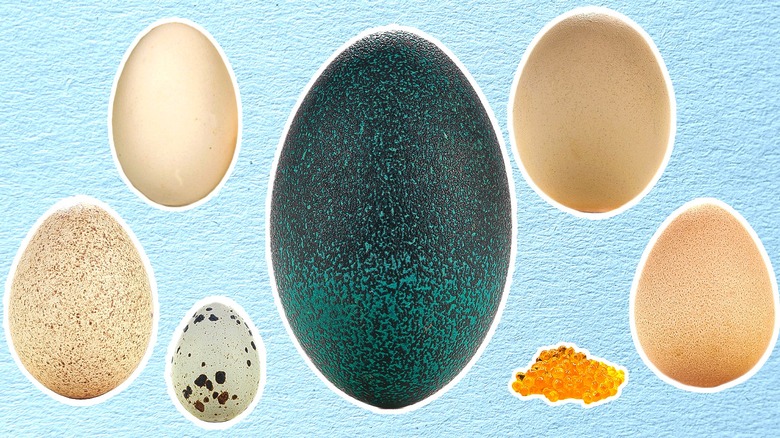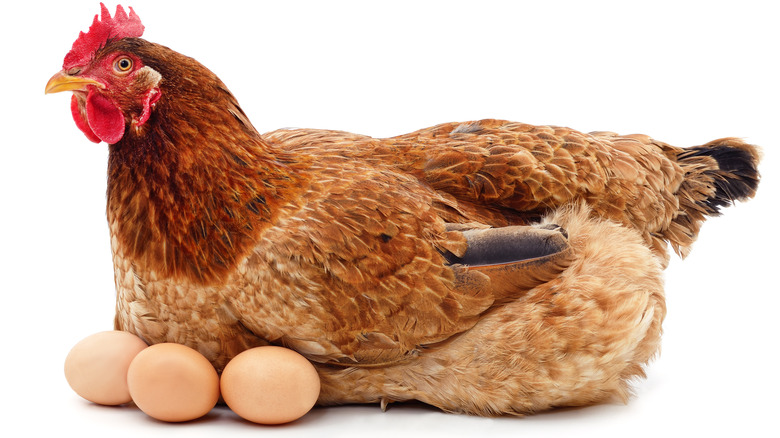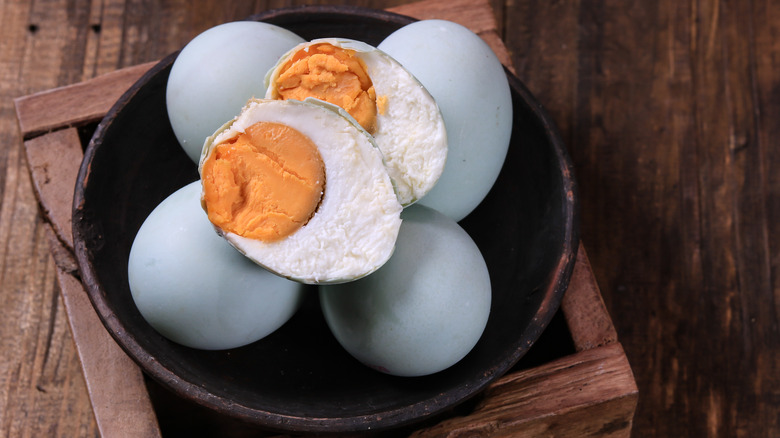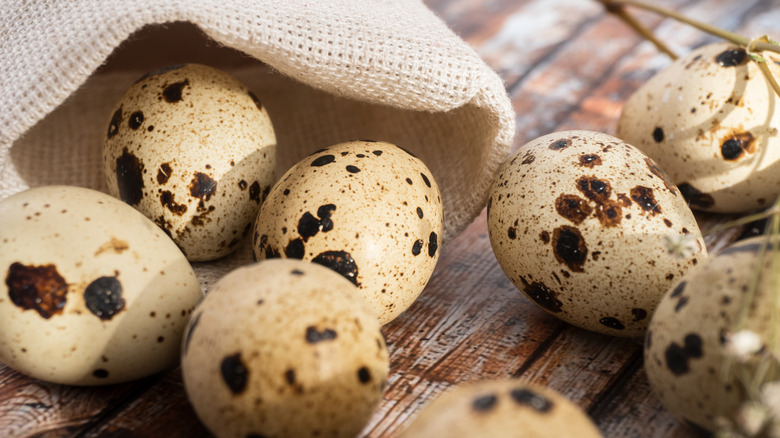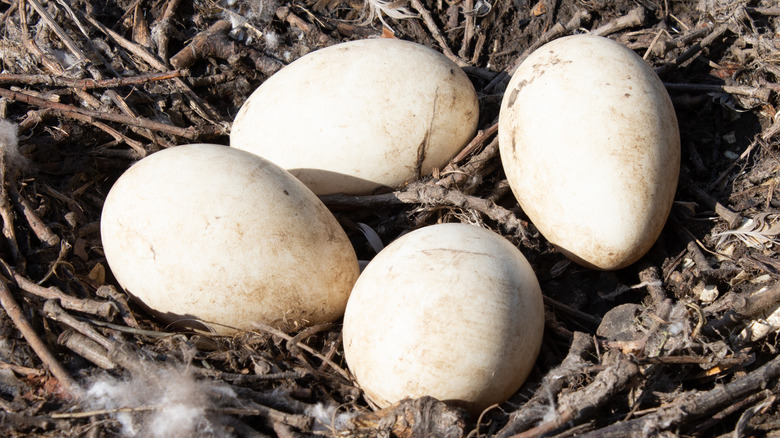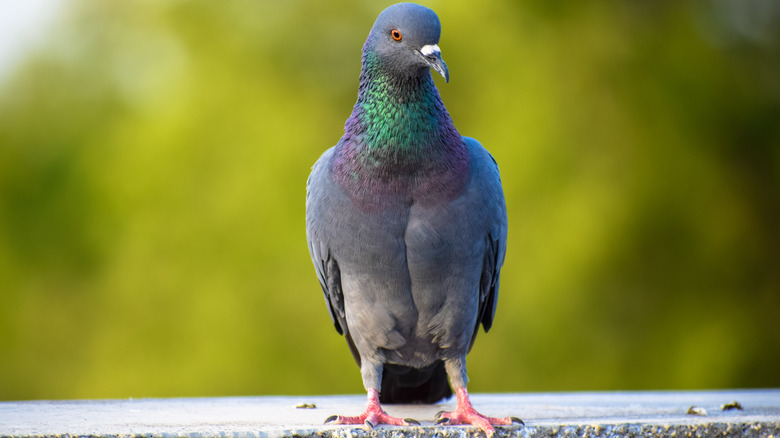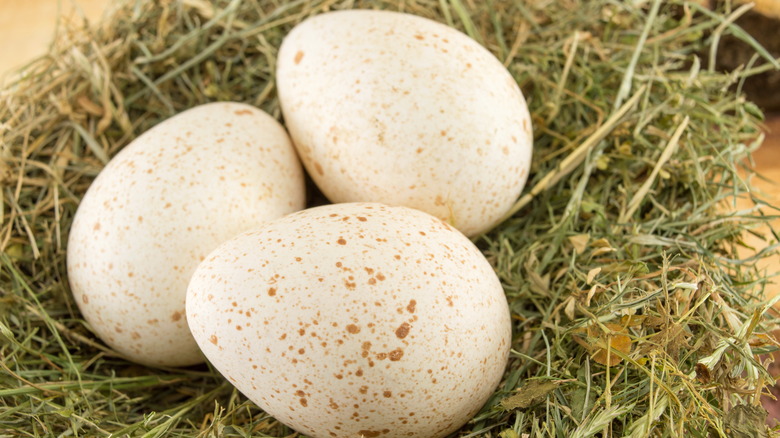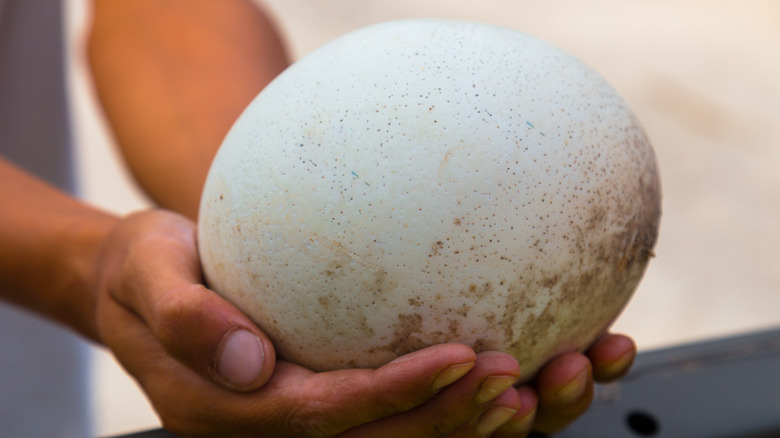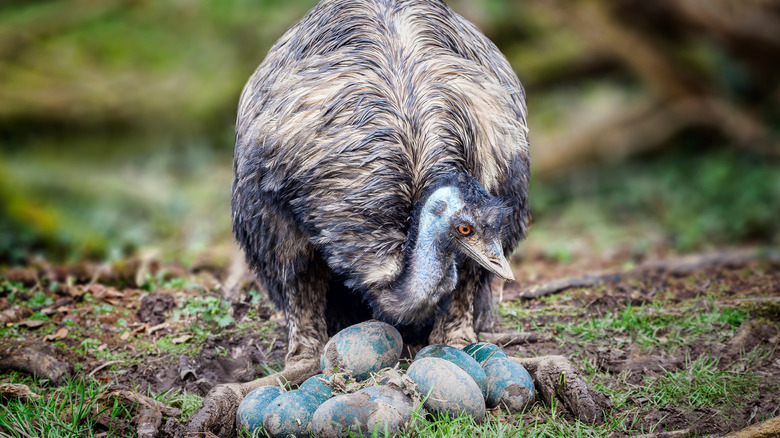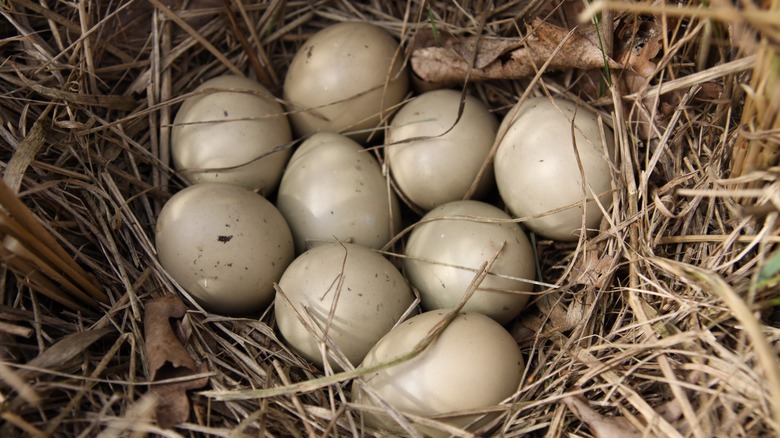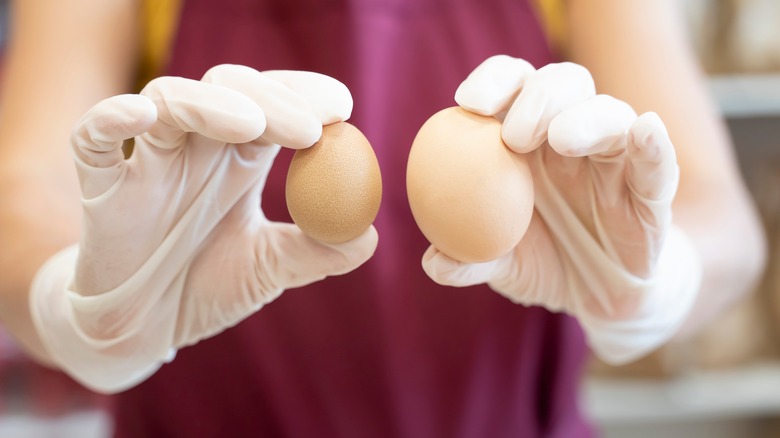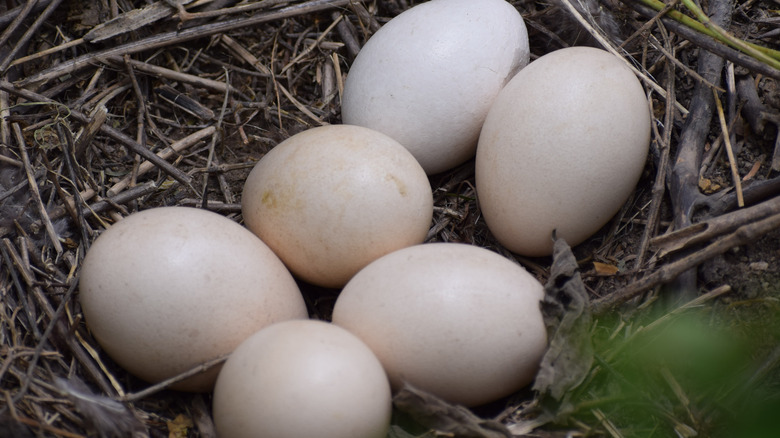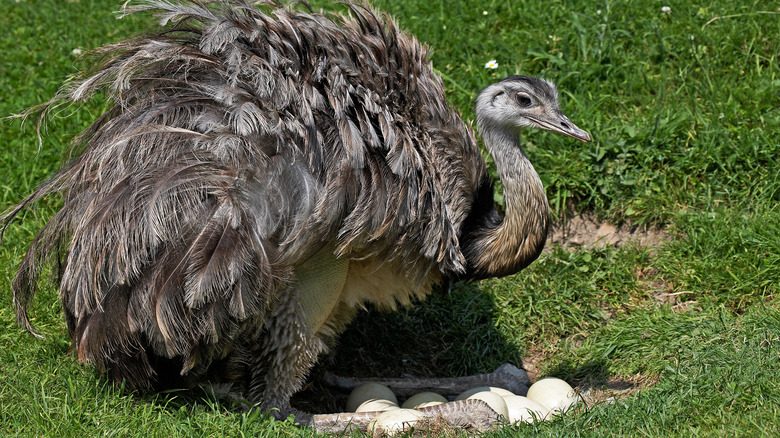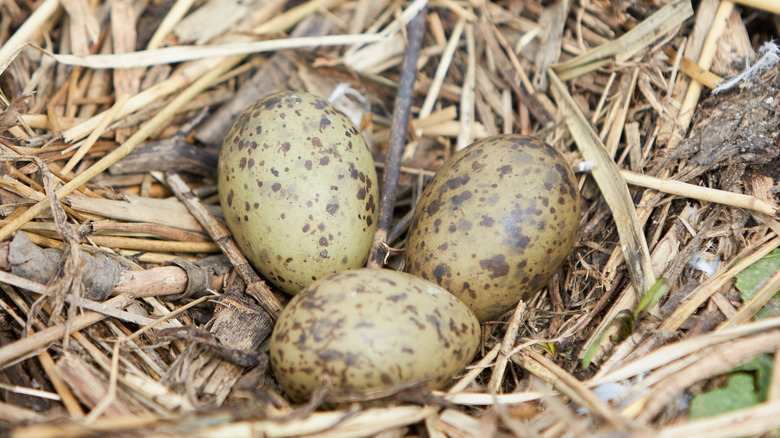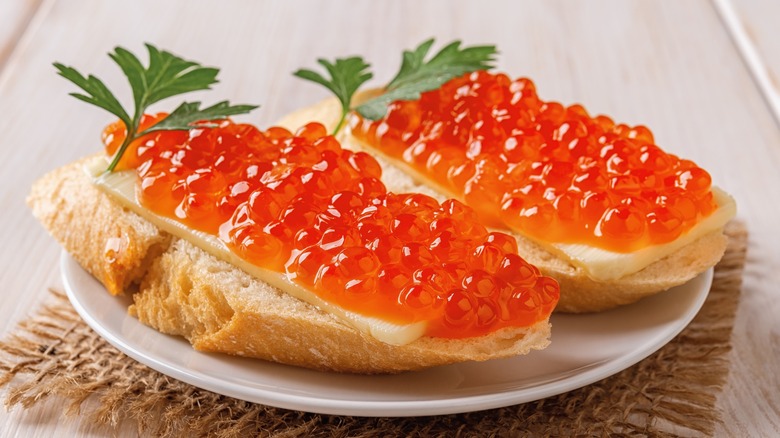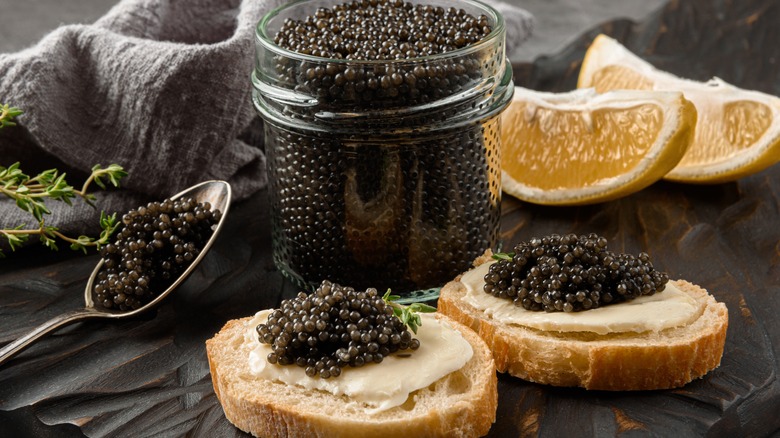18 Varieties Of Eggs, Explained
As much as we hate to admit it, our food choices are dictated less by our preferences and more by what Big Agriculture makes available. It probably won't come as a surprise, but it's not flavor or nutrition that farmers and food manufacturers put first — it's profit.
Nowhere is that more obvious than with eggs. Unless you're a super adventurous eater or have lived in a bunch of international destinations, there's a good chance chicken eggs are the only variety you've ever sampled. Now don't get us wrong, we love chicken eggs. From Saturday morning scrambles to frittata Fridays, these protein-packed ova hold an essential place in our kitchen. But they're not the only eggs out there, not by a long shot. In this article, we cover other edible animal eggs you should try. Some, like duck or caviar, you've probably heard of, while others, like ostrich or pigeon, might throw you for a loop. You don't have to like them all, but we encourage you to keep an open mind as we lead you through the eggs-tensive world of eggs.
1. Chicken
Let's start with the obvious one first. Unless you're following a vegan diet or have an allergy, there's a good chance you've got a carton of eggs in your refrigerator right at this moment. Eggs are some of the tastiest, easiest, and most versatile foods out there. They make for filling, nutrient-packed meals whether you serve them hard-boiled, scrambled, or sunny side up. When you're short on time, it's easy to combine them with veggies and cheese to make a no-fuss dinner omelet or quiche.
Although you're probably confident using eggs in your cooking, there are a few things about them that might surprise you. For instance, did you know that white hens lay white eggs and brown and red hens lay brown eggs? Or that they're sold by the dozen because Anglo-Saxons and Romans combined their measurement systems? In the new system, one egg cost one penny and 12 eggs cost one shilling (or 12 pennies).
2. Duck
From the outside, duck eggs have the same ovular shape as chicken eggs. They're also similar in color, with many ducks laying brown or white eggs. That said, there are quite a few differences between these two types of poultry. For starters, certain duck breeds lay light green, speckled, or even black eggs. Another notable difference is size. Duck eggs are about 50% larger than the largest chicken eggs.
The differences continue once you crack open a duck egg, which, coincidentally, has a much thicker shell than a chicken egg does. Inside, you'll notice a large, fatty yolk that's darker in color than chicken egg yolks. Chefs lust after these creamy insides when making everything from custards to omelets. But you don't have to be a professional to enjoy duck eggs. Thanks to their many similarities with chicken eggs, you can scramble, fry, or poach them as you normally would.
3. Quail
Similar to pheasants, quails are medium-sized birds that originated in North America. Nowadays, you can find different species of quail all around the world. That's good news because the speckled, grape tomato-sized eggs they lay are straight-up delicious. If you need some convincing, look no further than Jamie Oliver. From scotch quail eggs to pickled quail eggs, there are very few things the celebrity chef won't do with these tiny ova. Need more inspiration? Try our pea risotto with fried quail eggs and ham for a fancy take on Dr. Seuss' classic dish.
As you can see, it's pretty easy to swap out your tired chicken eggs for quail eggs. In fact, the two types are comparable in terms of flavor and nutritional value. For instance, 10 quail eggs contain about the same number of calories, fat, and protein as two chicken eggs. That said, there are some differences. Namely, quail eggs have more riboflavin, vitamin B12, and iron than chicken eggs.
4. Goose
These waterfowls only lay about 40 eggs per year, so you might have to go on a bit of a wild goose chase to track them down. Bird puns aside, what we're trying to say is that goose eggs can be tricky to find. On top of that, they cost a pretty penny (about $2.50 per egg) if you do manage to find them. Still, these eggs (which are about two to three times the size of chicken eggs) are worth the extra effort.
Because geese are usually raised in the wild, their diet is varied. As a result, their eggs are richer and eggier tasting than chicken eggs. Compared to chicken eggs, geese eggs have larger yolks and less egg white. This makes them a good option for ultra-moist baked goods. Their richness is also beneficial when making Spanish omelets or egg noodles. Just be careful about how many you eat: One goose egg has four times the calories and six times the cholesterol of a chicken egg.
5. Pigeon
When you hear the word pigeon, you probably think of those annoying birds that interrupt your picnic or defecate on your head. You're not wrong, but we do want to encourage you to look at these avian menaces in a new light by telling you about their eggs. For starters, did you know that traditional Chinese medicine has long prescribed pigeon eggs for energy flow and clear skin? And it's not just the Chinese who appreciate them. Pigeon eggs are a staple ingredient in Taiwanese street food, specifically QQ, a snack made by boiling pigeon eggs in soy sauce and slow-cooking them with herbs and spices.
On the bird egg size chart, pigeon eggs fall somewhere between quail eggs and chicken eggs. The shells are paper-thin and the eggs spoil quickly, so they're not the easiest eggs to cook with, but they're definitely worth trying if you ever get the chance.
6. Turkey
This game bird takes center stage come Thanksgiving and Christmas. So common is the holiday turkey that you've probably never stopped to think about turkey eggs before. The absence of turkey eggs (which are about 50% larger than chicken eggs) comes down to simple economics.
Hens lay about six eggs per week, compared to the two per week turkeys lay. Beyond their inferior egg-laying capabilities, turkeys need more space and food, two factors that make raising them more costly than raising hens. In fact, each turkey egg costs about $3. Cost considerations aside, turkey eggs are worth experimenting with if you're able to find them. Their flavor is similar to that of chicken eggs, albeit slightly creamier. For that reason, feel free to use them as you would a chicken egg.
7. Ostrich
As the largest bird in the world, it only makes sense that ostriches lay the most massive eggs we've ever seen — six inches long and (at least) three pounds to be exact. That's about 20 times the size of a chicken egg in case you're keeping track. Aside from being a site to see, ostrich eggs are also supremely delicious. The eggs of these flightless birds are rich, buttery, and slightly gamey.
Because of their massive size, scrambling ostrich eggs is the easiest serving option. If you've got a pan large enough and are up for a challenge, feel free to fry or poach them. Alternatively, ostrich eggs make a great addition to custards, bearnaise sauce, or baked goods that require a lot of eggs. If you're substituting ostrich eggs for chicken eggs, use two ounces of ostrich egg for every chicken egg the recipe calls for.
8. Emu
A delicacy around the world, especially in their native Australia, emu eggs are prized for their rich flavor and creamy yolks. Heck, even celebrity chef Geoffrey Zakarian keeps emu eggs in his fridge. Because they're so similar to chicken eggs, they blend seamlessly into all of your favorite egg-based dishes. As a starting place, consider cooking up an emu egg frittata or an emu egg fondue.
While the culinary options are nearly endless, there are several things to keep in mind when working with emu eggs. The first is their size. Emu eggs are about five inches long and weigh between one to two pounds each. That makes them about the size of 10 chicken eggs. Another thing to be aware of is their shell. Although the beautiful iridescent teal color is impressive, you'll curse it as soon as you try to crack it open. We recommend using a drill and a lot of patience.
9. Pheasant
Served in a savory pie, pheasant is King Charles' favorite meal. And the king isn't the only member of the royal family with a pheasant proclivity. Princess Anne is a big fan of deviled pheasants. As a main dish, pheasant has gotten the attention it deserves, but what about pheasant eggs?
Pheasant eggs are about the same size as duck eggs and have light green, brown, or off-white shells. Inside, the yolk is large and dark yellow. Nutritionally speaking, these eggs provide a healthy amount of protein, amino acids, and vitamins B9, B12, and D. Thanks to their creamy yolks and rich flavor, pheasant eggs are a popular base for fried scotch eggs and custard. They're also great boiled and served in salads or with a side of vegetables.
10. Guinea fowl
As its name implies, guinea fowl is a turkey-like bird native to the Western African nation of the same name. The bird's meat forms the backbone of Guinea fowl pot pie, a hearty comfort dish to end all comfort dishes. While you might be familiar with the meat, the guinea fowl's eggs are also a delightful treat, whether you decide to scramble them, poach them, or cook them into a frittata.
Although smaller than chicken eggs, guinea fowl eggs taste surprisingly similar to the eggs you grew up eating. However, they do have larger yolks in relation to their size. This fact, plus their varied diet, results in a creamier and richer egg flavor than you might be used to. Still, the two types of eggs are more similar than they are different, so feel free to use them interchangeably. Aside from being excellent chicken egg stand-ins, guinea fowl eggs pack a nutritional punch. They're high in protein, potassium, and iron. Plus, they provide a solid amount of vitamins A and B.
11. Peahen
Not to be confused with their larger, more colorful male counterparts, peahens are the female members of the peafowl family and the ones who do the egg-laying. Their eggs are white or cream-colored and resemble chicken eggs quite a bit, although they're slightly larger (about half an inch longer and wider). The shells are also thicker and tougher to crack, but the extra effort is worth it.
Peahen eggs have a yolk that's about one-third larger than chicken eggs. In terms of taste, they're comparable to chicken eggs, although they're usually richer and gamier. Don't let that throw you off, though. From quiche Lorraine to egg salad, peahen eggs make a fabulous addition to all of your favorite egg-based dishes. The only thing that might dissuade you from trying them is the price. One egg can sell for around $50!
12. Rhea
Native to South America, rheas are related to ostriches and emus. Like its cousins, the gangly rhea is massive and unable to fly. Despite its awkward appearance, the rhea lays some pretty impressive eggs. They're yellowish and measure about five inches by three and a half inches. If you need help with the math, that's about the same size as 10 to 12 chicken eggs. In terms of flavor, they taste surprisingly similar to chicken eggs. When compared to ostrich and emu eggs, rhea eggs have about the same proportion of yolk to white as chicken eggs do.
While they might be a decent chicken egg substitute, you'll have to go on a quest to find one. Some specialty grocery stores or farmers markets might carry them, but it's more likely that you'll have to special order them for a rhea farmer. If you do manage to find one, use it to make fluffy baked goods or surprise your guests with a massive rhea omelet.
13. Partridge
If you manage to get a partridge down from the pear tree, it would tell you to sample its tasty eggs. Like its cousin the pheasant, partridges lay slightly triangular eggs in hues ranging from white to light brown with speckles. While slightly smaller than chicken eggs, they boast a similar flavor profile, especially if raised in captivity. On the other hand, wild partridge eggs may have a gamier taste as a result of their diverse diet.
When you crack one open, you'll notice a large, dark yellow yolk inside. When cooking these little morsels, keep what you know about cooking eggs in mind, but be aware that you'll need to adjust the timing due to their smaller size. As an example, boiling a chicken egg takes around 10 minutes, whereas boiling a partridge egg takes about four.
14. Gull
Like pigeons, gulls (especially seagulls) conjure up feelings of annoyance more than anything else. We don't blame you for feeling that way, especially when you consider that some seagulls even steal food from grocery stores. But let's put their past indiscretions aside and focus our attention on the culinary gems that are gull eggs.
In England, British chefs clamor over black-headed gull eggs. These eggs are prized for several reasons. For starters, they're incredibly difficult to come by. The gull egg collecting season is regulated by law and is only open between April 1 and May 15. On top of their seasonality, there are all kinds of rules about when, where, and who can collect the eggs. But it's not their rareness that tempts chefs. It's their creamy bright orange yolks and delicate egg whites. To highlight the perfection of gull eggs, chefs typically soft boil them before pairing them with asparagus and celery salt.
15. Crocodile
If you've ever seen a crocodile at the zoo or in the wild, probably the last thing on your mind is getting closer to it than absolutely necessary. So, it might surprise you to learn that some brave souls in Australia (especially around Queensland) harvest crocodile eggs for human consumption. In fact, these white, three-inch orbs have long been considered a delicacy amongst the country's Aboriginal population.
Crocodile eggs have a fairly strong fishy taste. That may not sound super appealing, but boiling them does help tone down the fishy notes. Aside from boiling them, you can fry or scramble them as well. Whichever method you choose, make sure the eggs are thoroughly cooked so as to destroy any bacteria lurking under the shell. While novelty is their best selling point, crocodile eggs are also high in lecithin, a group of fatty acids that may help lower cholesterol and improve heart health (per Healthline).
16. Roe
Unless you've got money to burn, there's a good chance you've never eaten real caviar. Instead, you've probably sampled roe, a similar, yet vastly more affordable product. Both caviar and roe are unfertilized fish eggs. The main difference is that caviar comes from sturgeons, whereas roe comes from any number of fish. To put it another way, caviar is a type of roe, but roe is not necessarily caviar.
Japanese cuisine uses roe extensively when making sushi. Some popular varieties include ikura (red-orange eggs from salmon), kazunoko (solid yellow roe from herrings), masago (light orange eggs from capelin fish), and tobiko (red and crunchy eggs from flying fish). But the Japanese aren't the only ones to experiment with these bite-sized morsels. In Denmark, lumpfish roe is a popular addition to hard-boiled eggs and shrimp. The Greeks use tarama (aka salted and cured cod, carp, or grey mullet roe) as the base for taramasalata, a popular dip combining olive oil, lemon juice, and potatoes.
17. Caviar
Along with truffles, foie gras, and Kobe beef, caviar is one of those delicacies that lets you know you've really made it in life. Not only are these salt-cured sturgeon eggs a symphony for your taste buds, but they're incredibly expensive. Depending on the type and quality, the price can range anywhere from $42 per ounce for American Hackleback caviar to $830 per ounce for pure Beluga caviar.
The dwindling supply of sturgeon, paired with the high demand for the delicacy, are the main drivers behind these ridiculously high price tags. To begin with, wild sturgeon caviar harvesting has been outlawed for many years due to the species' declining population. Nowadays, almost all caviar is farm-raised. While more sustainable from an environmental point of view, the process remains labor-intensive and time-consuming (it takes a minimum of three years for each fish to start producing eggs). All of that said, if you can justify the price, sampling caviar is one culinary experience you won't soon forget.
18. Octopus
If you're a sushi fan, there's a good chance you've tasted octopus before, either in a tako roll or in sashimi form. Something you may not have tried, however, are octopus eggs. Also referred to as octopus caviar, these pale yellow, slightly translucent, tear-drop-shaped eggs may not look like other roes, but their flavor is quite similar.
Served raw, octopus eggs have a creamy texture and a mild brininess. Their accessible flavor profile pairs with familiar toppings like soy sauce, wasabi, and ponzu sauce. Like other roes, these eggs have a bit of springiness that gives a satisfying snap when you take a bite. When cooked, the flavor transforms, becoming sweet and slightly nutty. In Japan, chefs cook octopus eggs by steaming, poaching, or deep frying them.
